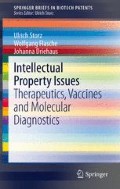Abstract
The high investments necessary to bring an antibody therapeutic to the market require a sound patent strategy. Although compound protection provides the broadest scope of protection, other ways of follow-up protection should be considered by innovators to achieve as long protection as possible. Further, in case a theoretical antibody against a given target is already prior art, innovators should be aware of methods to create compound protection for second or higher generation antibodies.
Access this chapter
Tax calculation will be finalised at checkout
Purchases are for personal use only
Notes
- 1.
Note The phrase “key patent” refers to only one member of a patent family that exists for the product. INN, international non-proprietary name.
- 2.
Storz (2010).
- 3.
Average Cost to Develop a New Biotechnology Product Is $1.2 Billion. Tufts Center for the Study of Drug Development, November 9, 2006. Available at http://csdd.tufts.edu/NewsEvents/NewsArticle.asp?newsid=69. Accessed on October 27, 2009.
- 4.
Grabowski et al. (2006).
- 5.
Stewart et al. (2011).
- 6.
EPO decision T542/95.
- 7.
Noelle v. Lederman, 355 F.3d 1343, 2004 U.S. App. LEXIS 774.
- 8.
Overington et al. (2006).
- 9.
U.S. District Court for the Southern District of California; case 10-CV-00608 BEN (GS) of Oct 17, 2011.
- 10.
Three-step approach, as applied in the BGH decisions “Kunststoffrohrteil”, “Schneidmesser I”, “Schneidmesser II”, “Custodiol I”, “Custodiol II”, GRUR 2002, 511–531.
- 11.
“Catnic test” as applied in Kirin-Amgen, Inc. v. Hoechst Marion Roussel Ltd. (2004) UKHL 46 (2004-10-21).
- 12.
Article 2 of the Protocol on the Interpretation of Article 69 EPC.
- 13.
Festo Corp. versus Shoketsu Kinzoku Kogyo Kabushiki Co., 535 U. S. 722 (2002).
- 14.
Biosimilars will be discussed in a later volume of this book series.
- 15.
See, among others, guideline EMEA/CHMP/42832/2005.
- 16.
The EMEA defines Biosimilars as follows: “The active substance of a similar biological medicinal product must be similar, in molecular and biological terms, to the active substance of the reference medicinal product. For example, a medicinal product containing interferon alfa-2a (…) should refer to a reference medicinal product containing as its active substance interferon alfa-2a. Therefore, a medicinal product containing interferon alfa-2b could not be considered as the reference medicinal product”.
- 17.
Scripps Clinic & Research Foundation v. Genentech, Inc., 18 USPQ 2nd 1001 (Fed. Cir. 1991).
- 18.
Scripps Clinic & Research Foundation v. Genentech, Inc., 18 USPQ 2nd 1001 (Fed. Cir. 1991).
- 19.
Abbott Labs. v. Sandoz, Inc., 566 F.3d 1282, 1300 (Fed. Cir. 2009).
- 20.
Article 54(5) EPC.
- 21.
The Swiss-type claim wording (“Use of a substance or composition X for the manufacture of a medicament for treatment of disease or condition Y”) had been found acceptable by the enlarged board of appeal in decision G 5/83 avoid a violation of the exclusion of therapeutic methods under old EPC (Article 52 (4) EPC 1973).
- 22.
35 U.S.C. 101: “Whoever invents or discovers any new and useful process, machine, manufacture, or composition of matter, or any new and useful improvement thereof, may obtain a Patent therefore”.
- 23.
Decision G2/08.
- 24.
Unigene Labs., Inc. v. Apotex, Inc. 06-CV-5571 (Fed. Cir. 2011).
- 25.
Gebauer and Skerra (2009).
References
Grabowski H, Cockburn I, Long G (2006) The market for follow-on biologics: how will it evolve? Health Aff 25(5):1291–1301
Gebauer M, Skerra A (2009) Engineered protein scaffolds as next-generation antibody therapeutics. Curr Opin Chem Biol 13:245–255
Overington JP, Al-Lazikani B, Hopkins AL (2006) How many drug targets are there? Nat Rev Drug Discov 5:993–996
Storz U (2012) Patent lifecycle management, supplementary protec tion certificates and data exclusivity in biopharmaceutics. In: Storz (ed) SpringerBriefs in Biotech Patents, pp 1–12. doi:10.1007/978-3-642-24846-7
Stewart M, Kent L, Smith A, Bassinder E (2011) The special inventive step standard for antibodies. EPI Inf 2:72
Author information
Authors and Affiliations
Corresponding author
Rights and permissions
Copyright information
© 2012 The Author(s)
About this chapter
Cite this chapter
Storz, U., Flasche, W., Driehaus, J. (2012). IP Issues of Therapeutic Antibodies. In: Intellectual Property Issues. SpringerBriefs in Biotech Patents. Springer, Berlin, Heidelberg. https://doi.org/10.1007/978-3-642-29526-3_1
Download citation
DOI: https://doi.org/10.1007/978-3-642-29526-3_1
Published:
Publisher Name: Springer, Berlin, Heidelberg
Print ISBN: 978-3-642-29525-6
Online ISBN: 978-3-642-29526-3
eBook Packages: Biomedical and Life SciencesBiomedical and Life Sciences (R0)

